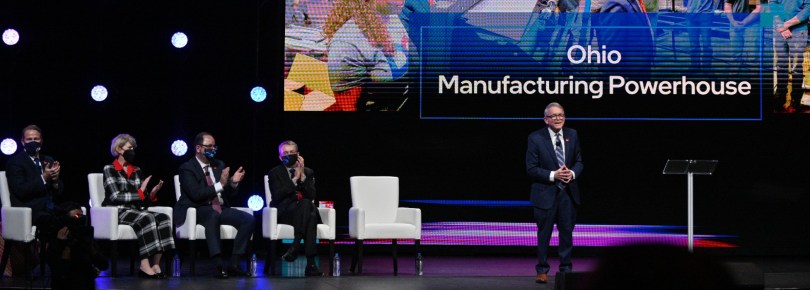
Photo via Ohio.gov
Since the explosion of sustainability movements across the world, companies have released corporate responsibility reports often with a section on how they plan to protect the environment for future generations.
Intel has outlined several sustainability goals for the two new factories. These goals include aiming to run on 100% renewable energy, meeting exceptional water conservation standards and sending zero waste to landfills by 2030.
“I’m not saying that Intel cannot do it — definitely they can if they wanted to. The problem is, at the end of the day, it kind of gets back to money,” Omid Bagheri, Ph.D., professor of economics at Kent State University told Climate360. “Although expensive, there are ways … but if that happens in the future, we have to wait and see.”
Cathy Cowan Becker, executive director of the sustainability organization Simply Living, in Columbus, Ohio, said she was closely watching the situation because of concerns about energy and water use.
“This plant is projected to use five million gallons of water a day, and they say that they can treat and recycle almost all of that water … [but] I mean, five million gallons a day is a lot of water” she told Climate360.
Cowan Becker has a lot of questions about how Intel can keep its water use efficient. Given how water is used in other industries, she wishes Intel would be more transparent about how it intends to recycle it.
“Fracking uses a lot of water; that water cannot be released. It is ejected into ejection wells and put underground because it is laced with so many chemicals, it cannot be used. How is the chip manufacturing process different?” she asked.
Transparency surrounding sustainability efforts may be difficult because the new Intel factories represent a huge investment into central Ohio that will bring jobs and income to the state. The plan fully built out could become a $100 billion investment and the largest semiconductor manufacturing site in the world. This is especially important at a time of global chip shortage due to the COVID-19 pandemic.
Chips, also known as semiconductors, are essential in many products. In addition to computers and smartphones, Intel chips are also used in cars, medical equipment, military defense systems and other items.
For Ohio to attract a large company like Intel, the state’s government likely had to provide numerous benefits such as tax exemptions and exemptions from certain regulations to edge out other competing areas.
“They want to maximize their profit. That’s the whole goal at the end of the day, right? So, what is in it for the state of Ohio, or any other state that offers them so many crazy benefits and crazy exemptions to make sure that they can attract them and bring them to their state? One word: employment,” Bagheri said.
Cowan Becker worries that Ohio may have compromised too much on environmental regulations in order to attract jobs.
“The sort of concerning thing about some of the stories I read is that one of the reasons they chose Ohio was a sympathetic regulatory process, like they kept saying that we don’t have the same regulations on the environment here as they do in, say, California,” she said.
Intel said it will keep working to meet its sustainability goals. In an email with Climate360, Fawn Bergen, Intel corporate sustainability manager, tried to reassure skeptics that Intel is committed to the goals laid out in its corporate responsibility report.
“Intel has demonstrated its commitment to sustainability and corporate responsibility for more than two decades, through setting and achieving ambitious goals, leading industry-initiatives for voluntary environmental impact reductions and being transparent about our successes as well as challenges,” she said. “We recognize the incredible importance of building trust with our communities and look forward to establishing and growing relationships with local Ohio community members.”
Bagheri said that while Intel has made ambitious goals for themselves, the only way to be sure they will deliver on their promises is through increased government oversight.
“Governments are the regulatory arm that can push companies and businesses to just play by some rules and make sure nothing bad is going to happen to the Earth or the environment,” he said. “Governments are supposed to be people’s representatives.”
Bagheri added that the only way for individuals to have an impact in getting meaningful environmental regulation is by applying pressure on the government.
“The only thing that we people can do is just pushing the government… Imagine every single person who lives in Ohio is just going on a street or writing or signing a letter asking for something. They cannot just ignore it — they have to do something about it.”
